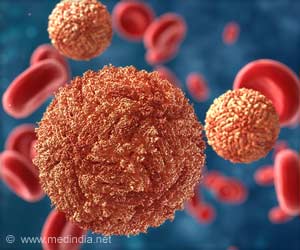A method to use body’s own cells and exploit a virus to eliminate metastatic cancer cells that spread from primary tumours to other parts of the body through the lymphatic system.
Researchers have come up with a method to use body’s own cells and exploit a virus to eliminate metastatic cancer cells that spread from primary tumours to other parts of the body through the lymphatic system. This research was done by an international team of researchers at the Mayo Clinic.
Besides, the study also shows that the new technique may pave the way for a new cancer vaccine to prevent cancer recurrence.The researchers have revealed that their procedure combines infection-fighting T-cells with the vesicular stomatitis virus, which targets and destroys cancer cells while leaving normal cells unharmed.
Although the procedure has not been tested on humans as yet, its results are significant as it describes a potential new therapy to treat and prevent the spread of cancer in patients.
“We hope to translate these results into clinical trials. However, until those trials are done, it’s difficult to be certain that what we see in mouse models will clearly translate to humans. We’re hopeful that will be the case,” Nature Medicine quoted Dr. Richard Vile, a Mayo Clinic specialist in molecular medicine and immunology and the study’s principal investigator, as saying.
Patients with cancers of the breast, colon, prostate, head and neck and skin often have most threat from the growth of secondary tumours, not from the primary tumours. The prognosis for such patients often depends upon the degree of lymph node involvement and whether the cancer has spread.
The researchers hypothesized that the spread of cancer could be controlled through the lymphatic system (bone marrow, spleen, thymus and lymph nodes) by manipulating the immune system.
Advertisement
For delivering the virus, the researchers removed T-cells from a healthy mouse, loaded them with the virus, and injected the T-cells back into the mouse.
Advertisement
They say that the immune response to cancer cells observed by them in this study indicates that their procedure may be used as a cancer vaccine to prevent recurrence. “We show that if you kill tumour cells directly in the tumour itself, you can get a weak immunity against the tumour, but if you use this virus to kill tumour cells in the lymph nodes, you get a higher immunity against the tumour,” Dr. Vile said.
He also revealed that the technique in the study had been successfully tested to treat the cells of three different diseases, namely, melanoma, lung cancer, and colorectal cancer to date. He further stated that the technology to extract T-cells from patients, attach the virus, and inject the cells back into the patients was already in existence.
A similar process was presently used by doctors to attach radioactive tracers to T-cells, while trying to find the source of an infection in patients, he added.
“This is technology that is relatively easy to translate to humans because it involves taking T-cells from the patient -- something routinely done today -- loading them with this virus and then putting those T-cells back into patients whose cancer has spread to lymph nodes, are at high risk of the cancer spreading to other parts of the body or are at high risk of succumbing to the cancer,” Dr. Vile said.
Source-ANI
LIN/P











